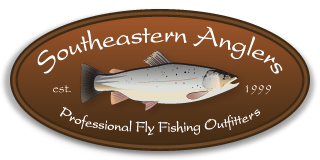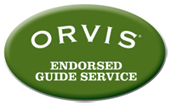



See also:
• Hiwassee River Delayed Harvest
• Guided Striper fishing on the Hiwassee River
The scenic Hiwassee River in Reliance, Tennessee is considered a tailrace fishery. The constant water temperatures provide for year-round trout fishing here. The Hiwassee Headwaters form on the north side of Unicoi Gap in Towns County, GA. The river is spelled Hiawassee in Georgia. It drains 750,000 acres. It flows 11 miles through a tunnel to Apalachia powerhouse. Our most popular float trip is from the powerhouse to Reliance, which is six miles and provides for a full day of good fishing. This section requires a competent Hiwassee River fly fishing guide.The next section is from Reliance to Hwy. 411, which is also 6 miles; from the powerhouse to the Hiwassee's confluence with the Ocoee River is 20 miles.
Hiwassee River Guided Fly Fishing Trips
The Hiwassee River is a wonderful guided fly fishing destination and is within two to three hours from Atlanta, Nashville, Knoxville and Birmingham. The river originates in northeast Georgia in the upper Chattahoochee National Forest. It then flows north into North Carolina and the Nantahala National Forest before it turns west into Tennessee. The Hiwassee Tailwater fishery begins in the Cherokee National Forest as it flows from TVA’s Apalachia Powerhouse. The tailwater section is about 21 miles long. The scenery on the Hiwassee tailwater is unparalleled, as it was the first river in Tennessee to be recognized as a State Scenic River. The upper river features an abundance of whitewater, deep runs, fast riffles, and big shoals that provide excellent fish habitat. The tailwater contains mostly rainbow trout and brown trout, with the average size running between 10” and 12” inches with larger trout possible.
Hiwasee River Dry Fly Fishing
The Hiwassee River is most noted for it’s wonderful dry fly fishing, as top water action can be found most anytime of the year. The hatches change with the calendar, as we’ll see many species of insects throughout the year. Our year begins for us in the spring with the early mayflies followed closely behind by the large hatch of grannom caddis. Late spring ushers in true blue winged olives and the beginnings of the sulphur hatch. The little yellow mayflies wrap up just as the large isonychias are beginning to get active in the summer heat. The Isonychias are one of our premier hatches as everyone loves fishing large dry flies and the hatch lasts through the summer and into late fall. Our Hiwassee River guides have their own special patterns. Big October Caddis keep us busy through the late fall as we wrap up the year with little baetis and white streamer patterns. The winter season can see many faces, sunny 60-degree days or gray, blustery days where the high temperature never reaches 40. The fishing holds well as the winter bite can range from baetis, little stoneflies, or even large white streamers for shad kill fish. this is delayed harvest season for our largest trout of the year.
The Hiwassee is a great river for the new fly angler as well as a seasoned fly fisherman, as catch rates are usually high. Our Hiwassee river guides love to teach newcomers here. The Hiwassee River is also a great destination for corporate outings involving 4 – 10 anglers (call for details on large multi boat trips).
Where to Go
The Hiwassee River can be divided into three distinct sections. Each section has its own unique characteristics and each section fishes best at different times of the year.
The upper section which is the powerhouse to Reliance; This is the Hiwassee river guide’s favorite section. The upper section is the most accessible and receives the greatest fishing pressure, except for the Gorge below Big Bend parking lot which has no road accessibility. The upper section boasts all major aquatic eastern insect hatches. Midge, caddis, stonefly and many mayfly species are present. This section is famous for its sulfur hatch in May and it’s Isonynchia mayfly in the summertime. Wading access is available roadside and the three mile John Muir Trail parallels the section from Childers Creek to Big Bend parking lot.
The middle section, which is Reliance to Highway 411. The middle section (from Reliance to Hwy 411) also usually fishes best early in the season; April, May and June. This is the easiest section for wading, but can also be floated with one turbine generation. This section is also predominantly known for its caddis hatches. Access for wading can be found at roadside picnic areas and Taylors Island.
The lower section, which is Highway 411 Bridge to Patty Bridge, usually fishes best from March to early May and is known for its huge caddis hatches.
Here are some facts you might find interesting about the Hiwassee River:
- Water release at the powerhouse takes 2.5 to 3 hours to reach Reliance.
- For all practical purposes, trout management started on the Hiwassee in 1980 as the Little Tennessee was dammed.
- Water quality in the Hiwassee River is exceptionally high, protected by State Wild and Scenic River Association.
- There is limited natural reproduction in feeder streams along the river.
- From October through March the river above Reliance is designated catch and release. All trout are protected under delayed harvest regulations.
When To Go
Trout fishing can be good year round. Insects generally hatch, and the dry fly fishing on the Hiwassee River can be good anytime waters are above 50 ° F. At others times, streamers and nymphs can be very productive. Most insect hatches occur April through November, but it is not uncommon to see baetis coming off on warm overcast January days. The winter midge fishing can be phenomenal. The water generation schedule is the most important factor to consider when planning a fishing trip. Generation schedules can be obtained from the TVA's website or by calling their toll free number which is 1-800-238-2264. Select option #22 for Apalachia Dam. Southeastern Anglers fly fishing outfitter is located on the banks of the Hiwassee River at Reliance, Tennessee; feel free to give us a call for an up to the minute fishing report (toll free 1-866-558-7688).
Fly Fishing Techniques
Many techniques are employed for fly fishing the Hiwassee River. Our Hiwassee river guides use drift boats. These drift boats allow you to access all the major areas in complete comfort and safety.
The all-around fly rod of choice would be a 9 ft., 5 or 6 wt. rod with a floating line. Sometimes when streamer fishing we like to use sink tip lines. Six and seven wt. rods sometime come in handy during very windy conditions or when we are using large baitfish patterns. During calmer days when fishing small nymphs and dry flies a 9 or 10 ft., 4 wt. rod is a lot of fun.
What to Do After Fishing
The Hiwassee area offers a variety of other activities for the non-angling members of your party. Activities including whitewater rafting, hiking, and camping are located in the immediate area. The towns of Etowah TN and Copper Hill TN located 20 and 40 minutes from the fishery, host a variety of antique and specialty stores as well as scenic landmarks. The Cherohala Skyway draws cycling enthusiast from around the country to drive across the scenic mountaintops.
Hiwassee River Delayed Harvest
Catch and Release season October through February
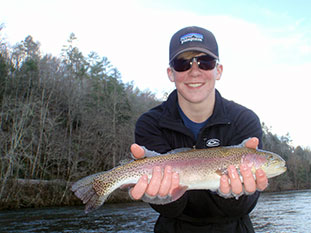
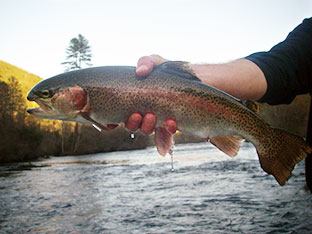

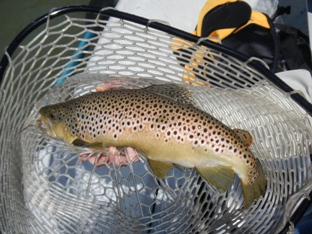
If it weren’t enough that we always have great spring and summer fishing on the Hiwassee. Now we have a real reason to enjoy the fall and winter fishing too. The Hiwassee River is the first and only tailwater in the state to garner “delayed harvest” trout fishing regulations. Tennessee Wildlife Resource Agency implemented the new program in the fall of 2011. Needless to say, it has been and continues to be a huge success. The 2012-2013 season is going gangbusters and we see the future of this new program as offering us a “second season” For great guided fly fishing on the Hiwassee River. Fall and winter fishing can be a combination of streamers, nymphs and sub-surface patterns as well as dry fly fishing. The major hatches include October caddis beginning in October and coming off until Thanksgiving. The small blue wings begin as the season cools off and continue through the winter. Egg and nymph patterns can be extremely effective during the delayed harvest season on the Hiwassee River.
The big attraction for your guided fly fishing trip during the DH season will be the shad hatch. Almost every year we have a shad kill in the reservoirs above Apalachia dam due to sudden cold snaps. These subdued shad will be drawn through the generators and drift through the tailwater below the powerhouse. This provides for some of the most exciting streamer fishing of the season. The trout will gorge on the bait fish and grow extremely fast. This winter food feast can also draw trout from throughout the river into the first several miles of water below the powerhouse.
Some of the highlights we like about guided fly fishing on the Hiwassee River during the DH season are: An increase in the catch rate of 12-16 inch average size fish. Catch and release regulations, a dramatic decrease in recreational boaters and rafters on the water, solitude on the river, hot shore lunches, greater possibilities for trophy browns, great streamer fishing, increased fish numbers. Guided fly fishing on the Hiwassee River during the delayed harvest season is hard to beat.
Guided Striper fishing on the Hiwassee River




Striper fishing in the summer time on the Hiwassee River is what some of our guides live for. Trout fishing is definitely our bread and butter, but guided striper fishing can be very productive on the Hiwassee River during summer. The striper run usually starts in mid June and can last into September. Every year is a little different. The trigger for the run seems to be post spawn for the fish when the water temperature in the main arm of the Tennessee River starts to warm. Where the fish can be found at any given time depends on the water temperature, flow rates, dissolved oxygen levels ,and other factors that we can only guess about. The stripers can be found in one location today and then gone tomorrow. Once the stripers arrive in the upper section of the river, we can usually find them until they leave the river. At this point the challenge becomes getting them to eat your fly or lure.
Guided striper fishing on the Hiwassee River is much like big game hunting or fishing. The best way to prepare yourself mentally for the day is as you would prepare for a day of tarpon fishing, marlin fishing, deer or elk hunting. Perseverance, stamina, and especially patience are required. The rewards can be tremendous. The size of the stripers caught here is well above the average of what you will find in most lakes or rivers. It is not uncommon to tangle with 30 pound beasts and 15 to 20 pound stripers are common when you catch them.
Here on the Hiwassee River at Reliance we have the luxury of a dual fishery in the summertime during the striper run. Rather than a relentless full day pursuit of stripers which can go unrewarded, many anglers will opt for trout fishing using lighter tackle during the morning and early afternoon, enjoy a good day of trout catching, and then try for the big stripers during the last few hours of the day using the big rigs. Many of these guided striper fishing trips will yield a good catch of trout and a trophy striper to boot.
Our guided striper fishing trips are artificial only. We do not use live bait. The most productive method is with medium to heavy spinning or casting gear. The lures of choice are plugs and swim baits. Certainly we also chase these big stripers with streamers. The rods should be 8 weights or better with floating and sinking lines using a variety of streamer patterns. We have the right gear to use.
